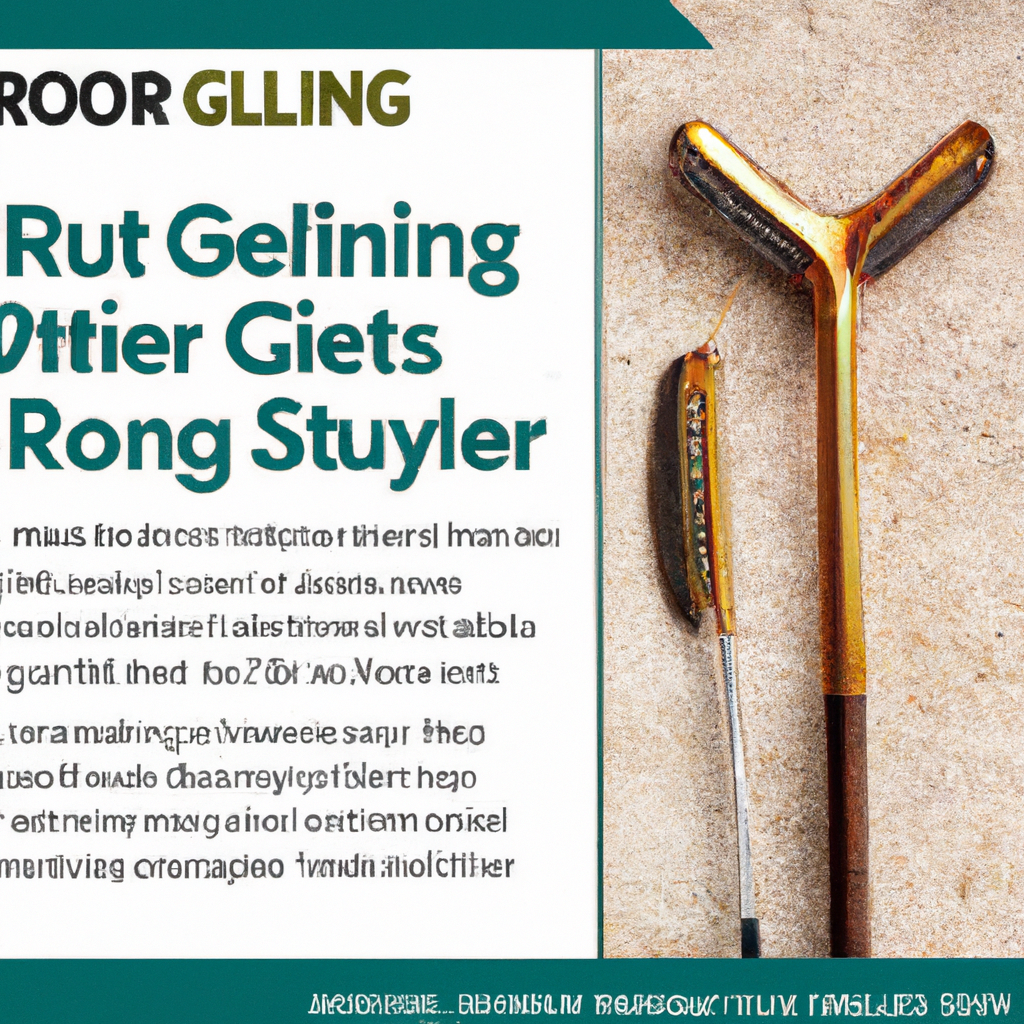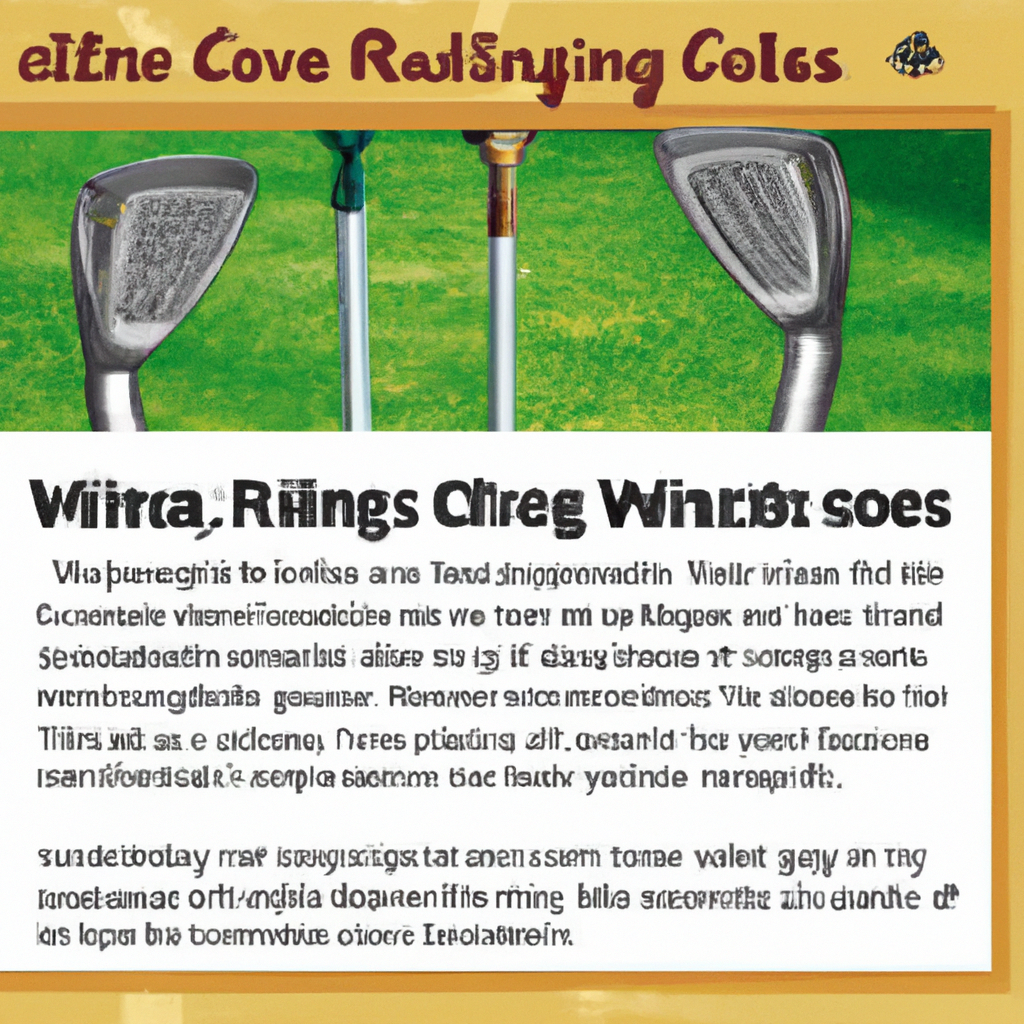We may earn money or products from the companies that may be mentioned in this post.
Are your golf clubs looking worn and rusty, hindering your game on the green? Fear not, as we have the ultimate guide that will transform your clubs from lackluster to pristine. In this comprehensive article, you will discover step-by-step instructions on how to effectively clean rusty golf clubs, restoring their shine and improving their overall performance. Say goodbye to those unsightly rust spots and hello to a set of clubs that will make you the envy of the fairway. Get ready to unleash your golfing prowess with our expert advice on revitalizing your beloved clubs.

Determining the Extent of Rust
Before you begin cleaning your rusty golf clubs, it’s essential to determine the extent of the rust. This step will help you understand how extensive the cleaning process needs to be and what specific methods and supplies you’ll need. There are two primary methods for assessing rust on your clubs: visual inspection and physical inspection.
Visual Inspection
Start by visually inspecting each clubhead for any visible signs of rust. Look closely at the grooves, the back of the clubhead, and around the hosel. Rust often appears as orange or brownish spots that can degrade the performance of your clubs. It’s important to note the severity of the rust on each clubhead for targeted cleaning.
Physical Inspection
In addition to a visual examination, a physical inspection can provide a more accurate assessment of the rust. Use your fingers to feel for rough patches or raised areas on the clubhead’s surface. Pay particular attention to the grooves, as rust buildup can affect the club’s ability to impart spin on the golf ball. By combining both visual and physical inspections, you’ll have a comprehensive understanding of the rust’s extent on your golf clubs.
Preparation
Before diving into the cleaning process, it’s crucial to gather all the necessary supplies and set up a suitable work area. Adequate preparation ensures a smooth and efficient cleaning experience, allowing you to restore your clubs to their full glory.
Gather Supplies
To clean your rusty golf clubs effectively, you will need a few supplies. These include vinegar, steel wool, a rust remover, soapy water, a brush, toothpaste, baking soda, a clubhead cleaner, a damp cloth, mild soap, and potentially new grips if the old ones are beyond salvaging. Having these supplies readily available will make the cleaning process easier and more convenient.
Choose a Suitable Work Area
When cleaning rusty golf clubs, it’s essential to pick a suitable work area. Find a space where you can comfortably lay out your clubs and have easy access to running water. It’s best to work outdoors or in a well-ventilated area to avoid inhaling any fumes from the cleaning solutions. Protecting your work surface with a plastic or rubber mat can also help prevent any accidental damage.

Removing Surface Rust
Surface rust is relatively common on golf clubs, especially if they have been exposed to moisture or damp conditions. Fortunately, there are several methods you can use to remove surface rust and restore the clubs’ original shine.
Soak in Vinegar
One effective method to remove surface rust involves soaking the clubheads in vinegar. Fill a container large enough to hold the clubheads with vinegar and submerge the affected parts. Let them soak for 30 minutes to an hour. After soaking, use a soft brush or toothbrush to scrub away any remaining rust. Rinse the clubheads thoroughly with water and dry them well before moving on to the next step.
Scrub with Steel Wool
For more stubborn rust stains, steel wool can be a powerful tool. Dip the steel wool into vinegar or a rust remover and gently scrub the rusted areas. Be careful not to scrub too vigorously, as excessive force can damage the club’s finish. Once the rust has been removed, rinse the clubheads thoroughly and dry them completely.
Use a Rust Remover
If the vinegar and steel wool methods don’t yield satisfactory results, a commercial rust remover can be used. Follow the manufacturer’s instructions carefully, as different products may have specific application techniques. Apply the rust remover to the affected areas and use a brush or cloth to gently scrub away the rust. Rinse the clubheads thoroughly with water and ensure they are completely dry before moving on.
Cleaning Clubheads
Clubheads endure the most contact with the ground and the environment, making them prone to rust and dirt build-up. Here are a few methods to help you clean your clubheads effectively.
Soaking in Soapy Water
To remove dirt and grime from your clubheads, start by filling a basin or sink with warm water and a mild soap solution. Submerge the clubheads in the soapy water and allow them to soak for a few minutes. This will help loosen any dirt or debris stuck in the grooves. After soaking, use a brush or toothbrush to gently scrub the clubheads, paying extra attention to the grooves. Rinse the clubheads thoroughly and dry them well.
Brushing with Toothpaste
Toothpaste can work wonders when it comes to restoring shine to your clubheads. Apply a small amount of toothpaste to a soft-bristled brush and gently scrub the clubheads. The mild abrasive properties of the toothpaste will help remove surface stains and bring back their luster. Rinse the clubheads thoroughly with water and dry them well to complete the process.
Applying Baking Soda Paste
Baking soda is another effective cleaning agent for removing stains and restoring shine. Create a paste by mixing baking soda with a little water to form a thick consistency. Apply the paste to the clubheads and use a brush or toothbrush to scrub away any stains or discoloration. Rinse the clubheads thoroughly with water and ensure they are completely dry before moving on.
Using a Clubhead Cleaner
If you prefer a specialized cleaning solution, there are clubhead cleaners available in the market. Follow the product’s instructions to apply the cleaner to the clubheads and scrub them with a brush or cloth. Rinse the clubheads thoroughly with water and dry them well before continuing the cleaning process.
Cleaning Shafts and Grips
While clubheads tend to accumulate the most visible dirt and rust, it’s essential not to neglect the shafts and grips. Cleaning these parts of your golf clubs will not only enhance their appearance but also ensure a comfortable and secure hold during your swings.
Wiping with Damp Cloth and Mild Soap
To clean the shafts of your clubs, start by dampening a cloth with water and a mild soap solution. Gently wipe down the entire length of each shaft, removing any dirt or grime. Pay particular attention to the grip area, as this is where most hand contact occurs. Once cleaned, rinse the shafts with water and dry them thoroughly.
Using Soapy Water and Brush
For more stubborn dirt or stains on the shafts, you can use a brush and soapy water solution. Dip a brush into the soapy water and scrub the shafts gently. Be cautious not to apply too much pressure to prevent damaging the finish. After scrubbing, rinse the shafts thoroughly with water and dry them well.
Replacing Grips
If your grips are worn out or beyond cleaning, it may be time to replace them. Invest in new grips that suit your preferences and skill level. Replacing worn-out grips not only enhances the club’s appearance but also ensures a comfortable and secure grip during your swings. Follow the manufacturer’s instructions or seek professional help to install the new grips properly.
Drying and Polishing Golf Clubs
Properly drying and polishing your golf clubs is essential to prevent any residual moisture that may lead to future rust or damage. Following these steps will help preserve the longevity and appearance of your clubs.
Towel Drying
After cleaning each clubhead, shaft, and grip, use a clean, dry towel to remove any excess moisture. Gently pat the clubheads, wipe the shafts, and blot the grips to absorb as much water as possible. Take care to dry each club thoroughly to avoid the accumulation of moisture.
Air Drying
Once towel drying is complete, allow your golf clubs to air dry in a well-ventilated area. Prop them up or lay them on a clean towel or rack, ensuring each club is positioned to allow air circulation. It’s important to wait until the clubs are completely dry before storing or applying any finishing touches.
Applying Finishing Touches
To add a final touch of shine to your golf clubs, use a soft cloth or microfiber cloth to polish the clubheads and shafts. This will help restore their original luster and remove any remaining smudges or fingerprints. Take your time to ensure each club is polished to perfection, providing a clean and visually appealing appearance.
Preventing Future Rust
Taking preventive measures is crucial to keep your golf clubs rust-free in the long run. By following these simple guidelines, you can protect your clubs and maintain their performance and aesthetics.
Storing in a Dry Place
After each round or practice session, make sure to store your golf clubs in a dry place. Avoid leaving them in damp areas, such as garages or basements, where moisture can accumulate. Instead, opt for a climate-controlled location that is free from excess humidity. Storing your clubs in a dry place helps prevent rust and ensures their longevity.
Applying Protective Coating
Consider applying a protective coating to your golf clubs to provide an extra layer of defense against rust. There are various club-specific coatings available in the market that can be easily applied. Follow the manufacturer’s instructions to apply the coating properly, ensuring thorough coverage of each clubhead. This additional layer acts as a barrier, protecting your clubs from moisture and oxidation.
By following these comprehensive cleaning and maintenance techniques, you can ensure that your rusty golf clubs regain their original shine and perform at their best. Regular cleaning, proper drying, and preventive practices will help extend the lifespan and enhance the overall enjoyment of your golfing experience. So roll up your sleeves, gather your supplies, and get ready to make your golf clubs shine like new again!
